It's when I paint that I gain certainty of living.
A discussion between the lyricist Paul-Henri Campbell and Aris Kalaizis about his Greek roots, the artistic awakening as well as the religious driving force in his paintings
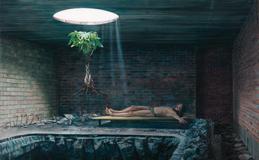
C: You were born in 1966. Your mother was a typesetter and your father a process engraver in the printing industry. You were initially trained in offset printing and later became a technician in the photo lab. After the fall of the Iron Curtain, you studied painting at the Academy of Visual Arts under Professor Arno Rink and became his Meisterschüler in 2000. Although you have Greek roots, you've spent your entire life in Leipzig. What do you associate with the term homeland or patria?
K: Yeah, true. I'm deeply rooted in Leipzig. I feel very connected with the lowlands of Saxony. My friends and family live here. But you asked about ›homeland‹, and I'm not sure if reference to a specific topography also equally implies a reference to one's homeland.
C: Comment on that a bit more, please?
K: But not only the place, in which one lives, but also the landscape, in which one never had been before, may equally be searched out and loved by the soul. You know, a hill in northern Greece may be closer to my heart than the sandstone native to the banks of the River Elbe here in Germany. Homeland is not always a question of being there on the ground.
Roots
C: While still children escaping the Greek civil war (1946−1949), your parents emigrated to what was then the Soviet Sector of Eastern Germany, the GDR. Both lived at a boarding school in Leipzig as thirteen and fourteen year old teenagers, where they grew up together with other Greek children. They came in contact with a foreign language and culture. How did your parents experience the diaspora?
K: My first conscious recollections of this date from 1980. I was fourteen then. It was at that age when I – probably driven by some inner necessity – to be interested in Greek things and the life of my parents. They lead a relatively simple and humble existence. You must know that by leaving Greece during the civil war, they not only left the country, but also were permanently separated from their parents. You probably can imagine what it means for a young person to be pulled out of life like that and to be forced to begin a new existence far away from his or her parents. Nevertheless, they never failed in offering my brother and me love as well as trust – despite our economically difficult situation at that time.
C: How would you describe the Greek impact in your work?
K: How could someone answer that question who never even learned about, say, the German forests and Greek mythology. You see, this brings us right back to our shaky understanding of homelands and all the thinkable detours that aren’t reflected in any passport. Certainly, I've been influenced by both cultures in this or that way, and both traditions, therefore, continue to exert their influence, even when I paint. I'm thankful for that, because this duality enriches me. But because of this specific condition there is nothing in my work that is exclusively German or exclusively Greek.
C: You are expressing something that I've noticed a lot in your work. You like detours and diversions.
K: True. In the life of my parents and my own, taking detours has brought out the greatest variety of experience.
C: How did you come to painting?
K: Having been a trainee in offset printing, I worked at a large printing company in Leipzig. At that point, I hadn’t had any intense encounters with the various arts. The only thing I used to do at that time was design covers for Heavy Metal albums and T‑Shirts. But I never thought of it as being particularly creative. However, that's how I came in contact with a circle of young workers at the printing company. It was a group of five or six apprentices who – far from what was the mainstream in the GDR – wrote poems, played music, or – well – painted. Even though, we all knew that our future would be somewhere beyond the printing industry or the printing machine, we enjoyed the groove that was between us and felt it to be vibrant as well as inspiring.
C: So that's the climate in which you became alert »artistically and awoke«?
K: Yes. There was a young guy in that printing company who had lost his arm in one of the machines. He had a strange name: Holger-Makarios Oley. He had nicknamed himself after the Cypriote archbishop Makarios III. After his accident, he had taken up engineering and worked in an office at the company. During breaks, I used to visit him there. At first, I only stopped in occasionally. One day, I was sitting in his office again. There was a desk between us. He asked to come around and pulled open the drawer, in which had hid away some cardboard, a few oil colors, and turpentine. Disregarding the fact that there's also a lot of characteristic history of the GDR in that anecdote, I was indeed fascinated at that moment — and infected. I remember how I hopped on the tram that day with a feeling of utter joy. I went to the bookstore and bought an incredibly miserably printed book with the pictures by a painter called Velázquez. It was only much later that I realized how important that painter would be for me. I couldn’t do a lot with that type of painting at the time, because I was more interested in the surreal worlds my friends lived in. At the time, I bought the book, which I still own, like other people buy manuals on »How do I Build a House« or »Tailoring made Easy«.
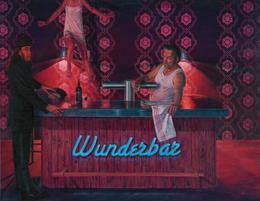
C: To me it's surprising that you became interested in preindustrial principles of art, while working in that industrial printing environment. How did your path continue from there?
K: I, of course, visited my friend Makarios every day in his office, or as often as I could, in order follow the progress he was making with the little painting in his drawer. When I got home, I told my father about my experiences. He sensed my enthusiasm and secretly built an easel out of scrap wood in our cellar, which he gave me as a gift on Christmas 1985.
C: Considering how late you began to paint, you must've been a quick learner and developed fast?
K: Maybe. But it shows how unexpected and coincidental events can change a life; just like that encounter changed the course of my life.
C: Meanwhile you've dedicated more than half of your life to painting. Every picture has a history. And every painter has a biography, in which these pictures have their place. Does the gaze ripen with time?
K: Certainly — every picture has a story. But only the first painting you every paint has its very own unique story, like a first book etc. Every painting you make after that is dependent on that first picture in one way or another. With every painting or book that follows, an ever increasing sequence builds up that is spurred by that initial work of art. For this reason, it is always tricky to analyze an individual painting by itself, because it is always the product of preceding products. But – to answer your question – does the gaze ripen, because after a number of years something like experience has collected. The increasing experience is – that next to all the ugly things – there is also something wonderful about aging. I wouldn’t paint any pictures that I've painted in my youth again in that way or even in any similar way.
C: None of them?
K: Not a single one of them. The skin isn’t the heart, you know.
Tradition in Dynamic Flux
C: Some of your paintings take up previous ones by citing elements or shapes used in those older pieces. Is that a way of depicting the biographic tension between painter and oeuvre?
K: Maybe in the first place it's necessary to explain that I subscribe to the notion of traditions in dynamic flux. According to this idea, one never insists on positions that have already been gained, but rather seeks to transpose them by introducing them into new terrain. For only in recognition of that which already exists, I'm able to convincingly design realms that I don’t know. If I, however, were to renounce my tradition, I'd only be drifting on unsteady foundations. I'd be forced to leap from one sheet of floating ice to the other — leaping indiscriminately from one experience to the next. Tradition in dynamic flux also requires some sort of critical acceptance of that which already has been achieved, while at the same time one is driving forth in a quest for the unknown and the uncertain. In doing so, I never want to create something ›new‹, but find nuances of something that is renewing. The most beautiful experience in trying to do precisely that is recognizing some sort of development, evolution, or growth — which is particularly gratifying because not every experience is always a development.
C: I'm interested in your affinity to that tradition in dynamic flux, however one may want to define the term. I'm thinking of your painting titled »Reoccurrence of a Farewell« from 2010. What is it exactly in those experiences that ignites the dynamism? In other words, what is the driving force in those experiences between you as an artist and the world that sets that tradition into motion?
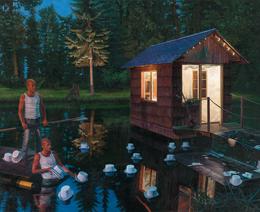
K: I see. Indeed, there is a sort of recognition in understanding that is necessary. But the non-recognition of certain experiences is also obligatory. For, as I said, not every experience brings about development. In this question, the audience plays a lesser role — simply because over the years, I've noticed which paintings requite love and which paintings didn’t really do that. But this question, I must answer independently from those experiences, because I'm not the accomplice of the well-meaning majority. Such a position would be awful and lead into an artistic dead-end. The example, you mention, »Reoccurrence of a Farewell« is programmatic, because in it I'm implicating an earlier painting (»Manchester« 2009). The only thing that those paintings have in common is white top hats.
C: How does this correlation exactly come about?
K: In »Reoccurrence of a Farewell« I'm attempting at creating a flow-effect by letting the older painting resurface. The white top hats from that older painting come to life once again within a new context. They are made to float towards a new center of gravity and, in the end, are transformed by taking part in an entirely new composition. In this new composition, the old painting is only something peripheral. And that's tradition in dynamic flux!
C: Suppose I claimed that there is a revisionist rationale in your notion of the tradition in dynamic flux, would you have any objections?
K: Well, if you mean we are not to linger on already achieved positions and manage our accomplishments, but instead we are to expand our capabilities and possibilities until they are entirely exhausted, then – yes – I'm a revisionist.
The Relationship between Painter, Oeuvre, and Audience
C: Let's talk about the flux you've mentioned a little more. I understand that you include anamnestic elements, memory devices, such as the top hats that serve as links to previous paintings. What is the significance of such a strategy in your opinion?
K: I'm happy to discuss circumstances that led up to a certain painting, but I find it hard to talk about meaning.
C: Why so?
K: Because I essentially work like a dentist who drills a cavity, but then leaves the gap open.
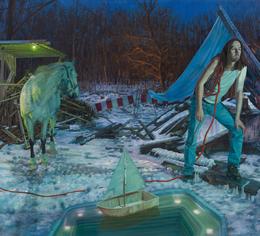
C: So, the filling is up to the patient or the beholder?
K: Absolutely! Meaning always involves interpretations. Let's assume I knew more than the beholder, and, as the creator of my paintings, ventured to ascribe meaning to it, I'd be in danger that people would keep too close to my interpretations. That would be ridiculous, especially because I couldn’t get at the intellectual and spiritual jewels of my beholders, which only emerge from their own individual engagements with the artwork. Certainly, there are gold fillings among them.
C: But isn’t there also a not so small number of artists who think otherwise, who …
K: … who take their audience by the hand. I don’t want to have anything to do with such artists. When I take a few steps back from the canvas, I imagine the most sublime persons possible looking at my work, autonomous beholders. For this reason, I just vanish behind my work and shut up, after a painting has been completed.
Silent Pause
C: But why not enter into dialogue?
K: Painting doesn’t really operate with language, but with pictures. In that context, language begins where the paintings aren’t strong enough, where they aren’t enough in themselves.
C: You've once said that the great artwork by, for instance, Jusepe Ribera or El Greco put you at a loss of words. And you also claimed that you'd very much like if after looking at a painting »silence« would befall the beholder.
K: Yes. That's what I said.
C: Could you comment on that?
K: What I meant was a silent pause that results from a contemplating gaze. This, of course, always presupposes that what is being looked at possesses the traits of greatness. The object of contemplation exceeds what words may say. Good painting is always in itself sufficient. That is all the relevant information that may spark such a reaction is contained in it. Whether it be my own life, my period, or the course of history itself – everything is contained within the painting. My paintings, therefore, are indicative of my relationship to art theory or literature and to almost everything. Not only what I read, but also how I read it, rapidly or slowly, all this impinges upon my painting. It enters into it like a sort of secret text, a hidden message, a symbol.
C: Before we shift from the artist's inner world to his external world, let's say that your paintings possess a certain privacy that comes across nonchalantly, but that is somehow also lurid. When contemplating your paintings by way of various detours, the outside world is revealed, a societal dimension emerges. Now, we could talk a great deal about the system that you make use of. Unlike many other artists, your painting works well without using superficial political layers or by invoking every external reference at hand. But how does the outside world affect the intimacy of your atelier?
K: Inside and outside. Those dimensions are complementary to each other. Without an image of the outside world, there isn’t an inward image either. To live also means to be moved by other things.
C: How am I to imagine this extraction?
K: Like the activation of the filter mode. Only in doing so, I remain less dependent on what you call the outside world. I mean I'm not built any differently than most other people. I also have my opinions on history. I have a lot of opinions. I'd even describe myself as political individual, somebody who is interested in what goes on in politics and the economy. But as an artist I need to try to keep these opinions or views at a distance.
C: Give me an example.
K: Well, not so long ago, I painted a figure form recent history for the first time in my career. It was Pope Benedict XVI, and I had great doubts about the project. You'll probably now ask, “why?” Because the biggest challenge in painting him was to make myself free from all my opinions regarding his person. I didn’t want it to be an exaltation of his figure or an unjust criticism. See, I'm not interested in being the decorator or caricaturist of my personal political views. This approach is in part also motived by my own desire not to be politically agitated when I look at paintings, but also by the desire to not be the collaborator of political agitation myself. This position is what agrees with my thinking, because I reject ideology. Instead as a painter I'd like to create a realm of possibilities in which there is enough space for the most diverse interpretations. And that's the hardest thing. Because art projects must be of a sublime nature, not just the document of a moment, else they won't survive the test of time.
C: Does that mean paintings are navigated via form rather than subject?
K: Exactly. For it is precisely the history of art that shows us how little it is shaped by ideas, but by forever new achievements of form.
C: What about making statements through artworks?
K: The painting – as I said – simply imparts information which may or could be formulated to statements by the beholder. But the statement is not made by the painter. It's made by the beholder. Those statements change over the course of time and also from beholder to beholder. That's why we admire the paintings by El Greco or Ribera, because we are constantly challenged by them. But if those painters hadn't found their form then we wouldn’t deal with them today – it's that simple.
C: In 1997 you said in an interview that you don’t believe the duality of content and form.
K: Yes — and I think that says it all. Look, there are people out there with incredible knowledge and education. They seem to have memorized entire novels, but as soon as they are asked to write their own novel, they fail. I like what the American John Dewey once said: »an ounce of experience is better than a ton of theory.« Because every experience can be verified: it is accessible and, therefore, more operational in our own actions. With respect to painting, this may mean that depicting an empty bottle may be more significant for the history of art than an entire panorama of the Thirty Year's War.
The Daily Routine of the Non-Private
C: May I ask you something personal, something private?
K: I haven’t got any privacy.
C: How so?
K: There is no separation between privacy and the professional realm in my life. After having worked as an artist for more than 25 years, my life has been structured by art and this has consequences in the most remote areas of my daily life. My life outwardly isn’t really interesting either. That's why I don’t need to veil it in secrecy.
C: Okay. That makes my list of discussion points a bit easier to work through. You live and work with your wife as well as your daughter, Nike in a former industrial complex that has now been converted to lofts at the heart of Leipzig. And if there isn’t a privacy sphere, then let me go right on to ask you about your daily routine. How do you begin your day?
K: With something ridiculous — with ten to twenty minutes of gymnastics.
C: Why gymnastics in the morning?
K: In order to be fit and flexible for my work.
C: Is painting so exhausting?
K: Yes, it is exhausting — sometimes more, sometimes less and occasionally causes perspiration. The physical exercise that I mentioned is more about enduring the hours in the atelier than being buff. And in order to stand, you simply need your knees, which in my case have been damaged by long years as an active soccer player. So, I do gymnastics in the morning, so that my handicap doesn’t turn into a hazard.
Spirituality, Faith, and Atheism
C: In an essay about your work, I talked about your dramatization of the turning points and thresholds of human existence. Looking at your work, I feel as though the numinous forces, the powers unseen are important in it. My question aims at the religious impetus in your paintings, because your paintings are not only documents of a yearning for the epic or the mythical, but also express a certain sense of sanctity. I know that you used to describe yourself as an atheistic Epicurean. But let me ask about your religiosity. What would you say if I claimed to have traced some sort of religiously motivated intent in your paintings?
K: If you mean a drive towards desire and speculation, then I'd be okay with what you said.
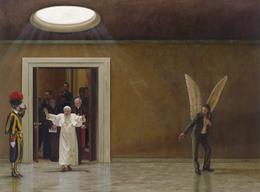
C: But, if you don’t mind, I think that there isn’t a pious adoration of directives, but rather a questing religiosity. It comes out in the painting involving the pope (»make/believe«) more than in many other ones.
K: Could be. As I mentioned, I don’t like commenting myself on individual paintings. With respect to my desires and my quest, I can merely tell you that a world, which we experience empirically, needs to be transported into a world that we will hardly or scarcely recognize. I don’t work in documentary painting. Ultimately, everybody senses some sort of spiritual connection with the whole of the cosmos. But that isn’t only something religious, but also something very human. The religions of the world have never really inspired me very much with their simple, though amusing stories of creation. Whereas the mystic seems to refuse to subsume the more broadly felt stories of the whole of the cosmos into one tale that wouldn’t achieve the poetry inherent in that cosmos.
C: The mystic experiences the limits of his own spirit and his own body as a search, an endless search.
K: And to search for something is possibly more difficult, because it's more demanding, but it feels more as something that is truly experienced, than the certainty of the faithful who believes to have arrived already.
C: How am I to understand the transition from the world-as-it-is to a possible world?
K: How am I to describe a condition that has emptiness as its goal?
C: By saying emptiness, you mean a condition that evokes otherness or the other?
K: When I complete a painting, all the experiences that had been so present within me, consciously or unconsciously, while working, stay with me and continue on. That's why I need to shake off the old painting before I can embark on a new project. It is necessary that I build a distance between myself and old painting – and bid it farewell. Dismissing the old one and the emptiness desired therein aims at creating sensitivity and to make me receptive to whatever may be next.
C: Now I understand why I've always only seen one painting in this large atelier here. Your working environment looks so neat and cleaned up.
K: Well, yeah.
C: Let me revisit the issue of the world-as-it-is and possible worlds, because I'm interested in the moment when it tips from one side to the other. What happens in this transformative process? What happens to you?
K: There is a moment of stillness and darkness, as though death were waiting for me.
C: In a condition of inward immersion you envision imaginary constellations that are usually not there in your everyday experience, right?
K: Well, the pictures have to come to me. I can’t go to them.
C: What happens exactly, when the pictures – as you say – have come to you?
K: It's as though everything has fallen into place, as though the universe and I become one for that moment. It's in incredible impulse. But without that impulse of absolute joy, without that moment of ecstasy, I wouldn’t be able to paint at all. Every painting is the beginning of a dalliance.
C: And how long does the dalliance sustain you?
K: The energy has to at least suffice until I make the final brushstroke. If that isn’t the case, then the picture is doomed before it has been completed. Bringing a new picture into existence, is really like bringing a new child into the world – except that the painting is to be on its own as soon as it's there, while a child is entitled to some nursing. So, in addition to that joyful impulse, there is a further requirement: good craftsmanship. And that's what matters – be it literature, sculpturing, or painting.
C: Earlier you compared the artist to a dentist. When people talk about your art, do you sometimes get a toothache? A when people like that New Yorker art historian coined the term »sottorealism« while discussing your work.
K: No not at all! Even though I'm not sure yet whether the term will define a period…
C: Well, but for now the term is with us. How do you feel when the concrete work of the painter enters in the abstract world of art criticism?
K: As far as the discussion of my work is concerned, I'm not much of a participant, but rather someone watching. But it is always lovely when paintings are able to spark numerous interpretations and sometimes even neologisms. The paintings are designed to spark autonomous reflection. What do you want me to say? Maybe, at the moment, any neologism is better than any genre description or periodization. Maybe it indeed does somehow describe how I work. After all, it's an approach that I've been practicing for the past 15 years since the painting titled »The Visitor«. When I construct a model and then carefully consider and assess my initial impression by going through that model, I'm less prone to succumb to the labyrinth of sudden ideas and get lost in it. At the same time, it's more comfortable to work with and a wonderful experience, to navigate through models of entire scenes that had only been in your imagination until you built them up. And by snooping around in those models, I can make corrections to the design before I get to the canvass. And then I feel the blood run through my veins and have the certainty that I'm living.
©2014 Paul-Henri Campbell | Aris Kalaizis
Paul-Henri Campbell was born in 1982 in Boston (USA). He studied Classical Greek and Roman-Catholic Theology. He is writes poetry in German as well as English. Since 2013, Campbell is co-editior of the annual anthology »German Poetry Now«. His most recent publications include »Space Race« (2012) and »Am Ende der Zeilen« (2013).